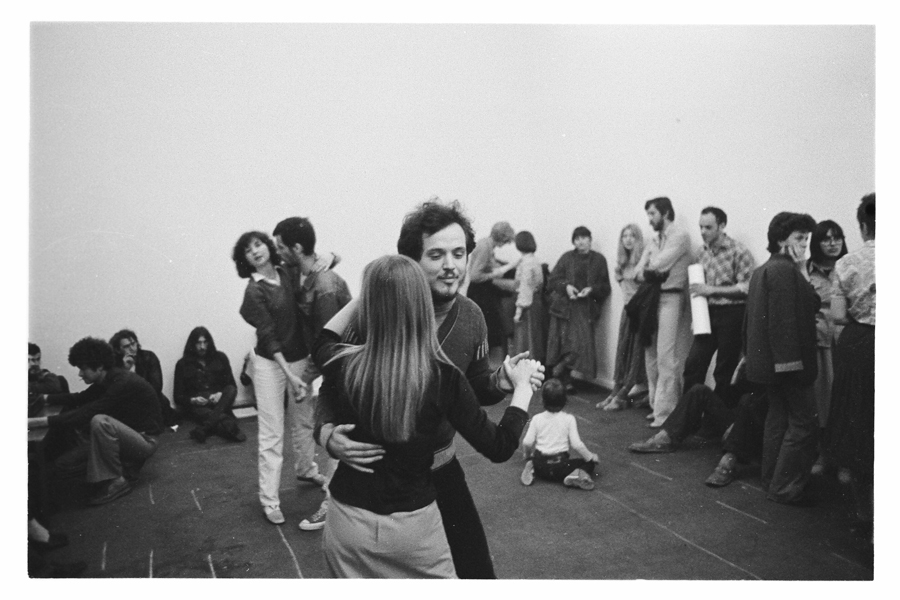The Opening is faithful to its title. These eight works by Sanja Iveković and Franco Vaccari, ranging from 1969 to 1978, are based on actions they carefully orchestrated during their own vernissages. Both Iveković (Croatian, b.1949) and Vaccari (Italian, b.1936) were pioneers in experimenting with new media, and used photography and single-channel video as devices for activating social interaction and including audience response in their works, instead of merely recording it. Both, and well before the digital era, confronted the issues of surveillance and expanded narcissism that such devices implied. In the early stages of their careers, documented by this exhibition, they also employed the standardised Narrative Art format of typewritten text and black-and-white photos to plan and record their actions, so that their formal correspondences are evident. It is thus quite surprising that Iveković and Vaccari had to wait over 40 years to be asked – by curator Marco Scotini – to exhibit together again. The last time had been in Graz, in 1973, during the audiovisual biennale Trigon 73, involving artists from Austria, Italy and what was then Yugoslavia. A young and smiling Iveković, wearing a black T-shirt with the Trigon logo and a miniskirt, can be spotted in one of the pictures (printed here for the first time) shot by Vaccari inside Secret Communication, his environment at the city’s Neue Galerie: it consisted of two spaces linked by a camera mounted atop a monitor and a magnetophone – an ancestor of Skype, one thinks.
Obvious similarities makes differences more visible: those, for instance, in attitudes to shaping a relation with viewers. Vaccari was mostly interested in exploring real time and the connection between ‘photography and the technological unconscious’, as he titled his excellent 1979 book on the subject. To place the public centre stage, he often removed himself from it. On show here is documentation of Exhibition in real time N.1, staged in Modena in 1969, the first of a long series of durational ‘events’ that Vaccari refused to label as happenings or performances. The best known of these was Exhibition in real time N.5, held at the 1972 Venice Biennale, where the artist installed a photobooth and asked visitors to ‘leave a photographic trace of your passage on these walls’, and hence to contribute to the work’s collective authorship. During the seventh, Instantaneous Myth (1974, at Gallery 291, Milan), some viewers were portrayed via a Polaroid; when their image, blown up to monumental dimensions, was projected on the walls, Vaccari took a final picture of each subject and its magnified double.
By contrast, Iveković aimed at establishing a contact with the public focused on her body, as her radical feminist works of the following decade would demonstrate. In the single-channel video Inter Nos (Between Us, 1978), we see her exchanging kisses, caresses and intimate gestures with men and women attending her exhibition at the Students’ Gallery of Multimadijski Centar (MultiMedia Centre) in Zagreb, 1978. She touched them only virtually. Again, the space was split into two rooms connected by CCTV cameras. Iveković sat alone in the first one; when a viewer entered the other, she started to play with his/her screen image, while the audience outside could see only the visitor’s face and expressions. A few days before, during another opening at Tommaseo gallery in Trieste, Iveković had greeted her guests with her mouth taped, but also with the request that she meet them one by one behind a curtain: during the encounter, the artist’s heartbeat was amplified live, as well as recorded on tape, while a photographer chronicled the scene. In the following days, the gallery presented the tapes as ‘captions’ for each image. I’ve probably grown a tad too cynical, but while listening to Iveković’s heart, I found myself wondering when and if, today, I would have a chance to experience such an emotional, unfiltered interaction with art by attending an opening.
This article was first published in the April 2015 issue.
